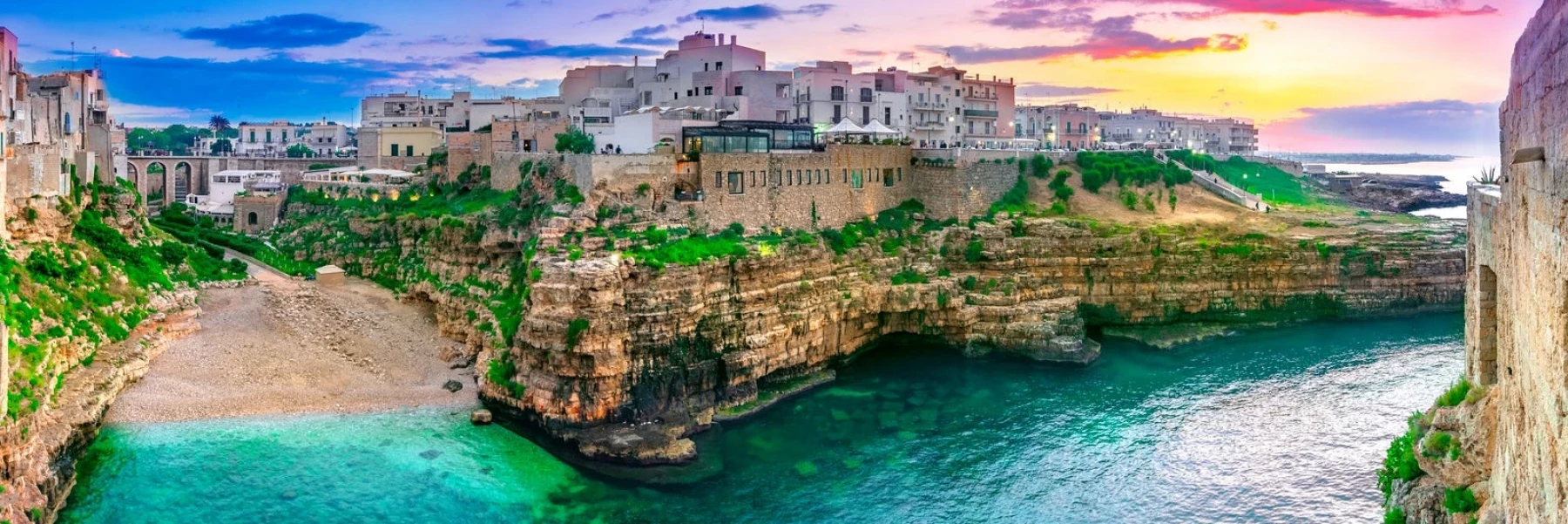To visit - Puglia
Welcome to Puglia, a southern Italian region that unfolds like a living canvas, showcasing diverse landscapes, picturesque villages, and a rich Mediterranean history. Puglia, also known as the "heel of Italy's boot," provides a unique and enchanting experience. Here's a description of this region for a travel theme:
Puglia, bathed by the crystal-clear waters of the Adriatic and Ionian Seas, captivates travelers with its harmonious blend of centuries-old traditions, delectable cuisine, and breathtaking natural panoramas.
The Trulli of Alberobello: Puglia is renowned for its trulli, conical stone houses with thatched roofs. Alberobello is the iconic location where these unique structures create an enchanting landscape, immersing visitors in the traditional architecture of the region.
White Sandy Beaches: Puglia boasts beaches with crystalline waters and white sands, including the beach of Polignano a Mare. The coasts offer picturesque coastal landscapes, featuring sea caves, natural arches, and limestone cliffs.
The Itria Valley: This picturesque valley is dotted with endless olive groves, lush vineyards, and whitewashed towns. Locorotondo and Cisternino are gems in this region, offering narrow streets and lively squares.
Puglian Cuisine: Puglia's cuisine is a feast for the senses, showcasing dishes such as orecchiette pasta, taralli, extra virgin olive oil, fresh seafood, and local wines like Primitivo. Local markets abound with fresh produce and authentic flavors.
Lecce, the Florence of the South: Nicknamed the "Florence of the South," Lecce is famous for its exuberant baroque architecture, ornate churches, and vibrant atmosphere. Explore the narrow streets of the old town and marvel at the impressive architectural details.
The Tremiti Islands: This small archipelago off the coast of Puglia, comprised of several islands, offers crystal-clear waters ideal for diving and relaxation. San Domino and San Nicola are among the most visited.
Puglia unveils an authentic Italy, steeped in local traditions, enchanting landscapes, and warm hospitality. Amidst endless olive groves stretching as far as the eye can see and well-preserved villages, this region offers an unparalleled Mediterranean getaway.
The 12 essential things to do in Puglia. :
Summary
- To visit
-
- 1 - Bari, the capital of the Puglia region
- 2 - Polignano a Mare
- 3 - Alberobello
- 4 - Monopoli
- 5 - Castel del Monte
- 6 - Caves of Castellana
- 7 - Ostuni the white city
- 8 - Lecce
- 9 - Brindisi
- 10 - Gargano National Park
- 11 - Matera
- 12 - Les îles Tremiti
- Puglia - Where to Stay?
- Puglia - How to get around?
- Puglia - Best period
1 - Bari, the capital of the Puglia region
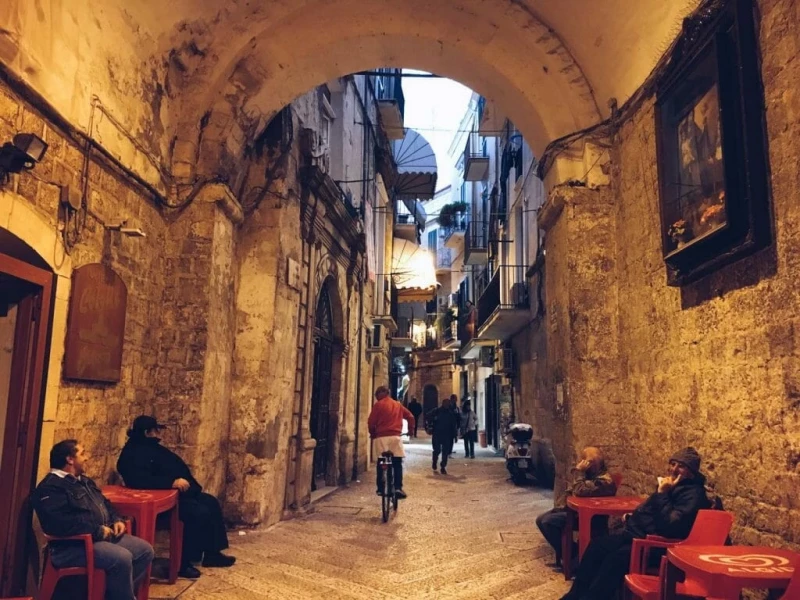
Certainly! Here's a travel-themed description of the city of Bari in English:
1. Gateway to the Puglia Region: Bari, the jewel of Puglia in southern Italy, serves as the gateway to the diverse cultural and natural wonders of this region. Its winding streets, ancient architecture, and warm atmosphere invite travelers to immerse themselves in the essence of Mediterranean life.
2. Religious Heritage at the Basilica of Saint Nicholas: At the city's heart lies the majestic Basilica of Saint Nicholas, a millennia-old place of worship. With its imposing architecture and deep religious history, the basilica attracts both pilgrims seeking spiritual connection and art enthusiasts marveling at its priceless treasures.
3. Bari Vecchia, the Soul of the City: Wanderlust leads travelers through the picturesque alleys of Bari Vecchia, the old town. Lively squares, ancient churches, and welcoming locals create an authentic atmosphere where history seems frozen in time.
4. Teatro Petruzzelli, Artistic Elegance: Teatro Petruzzelli, the largest opera house in Puglia, enchants with its elegant architecture and internationally renowned performances. An evening here provides insight into Bari's cultural refinement.
5. Mediterranean Gastronomy: Bari also stands out for its delightful cuisine. Travelers indulge in local specialties, from fresh pasta to seafood, at traditional trattorias and bustling markets like Mercato Coperto.
6. Lungomare Promenade, the Call of the Sea: The Lungomare promenade, tracing the Adriatic Sea, offers a soothing escape. Travelers stroll along, absorbing the sea breeze and enjoying panoramic views of the port, creating serene memories.
7. Authentic Encounters: Warm and welcoming, Bari's locals gladly share their passion for their city. Travelers have the opportunity to immerse themselves in local daily life, forging authentic and lasting connections.
8. Bari's Walls, Remnants of the Past: The ancient walls surrounding the old town serve as reminders of Bari's defensive past. Travelers can explore these remnants, soaking in the strategic history of the city.
Bari, with its captivating blend of ancient traditions and Mediterranean modernity, offers a rewarding travel experience where history, culture, and hospitality converge in the heart of Italy.
 Our tips for getting the most out of your experience.
Our tips for getting the most out of your experience.
Visiting Bari can be a rewarding experience, blending history, culture, and Mediterranean cuisine. Here are some tips to make the most of your visit to Bari:
-
Explore the Old Town (Bari Vecchia) on Foot: The narrow streets of the old town are full of charm. Explore on foot to discover ancient churches, picturesque squares, and the authentic daily life of the locals.
-
Taste Local Specialties: Don't miss out on Bari's culinary delights. Try the famous "orecchiette" (ear-shaped pasta) and fresh seafood in local trattorias. Visit the Mercato Coperto for an authentic market experience.
-
Visit the Basilica of Saint Nicholas: Explore this iconic basilica that houses the relics of Saint Nicholas. Be sure to visit the crypt to discover its fascinating history.
-
Stroll Along Lungomare Promenade: Enjoy a walk along the Adriatic Sea on the Lungomare promenade. It's a great place to relax, admire the views, and perhaps indulge in some gelato.
-
Attend a Performance at Teatro Petruzzelli: If your schedule allows, attend a performance at Teatro Petruzzelli. It's an opportunity to experience a unique artistic performance in the largest opera house in Puglia.
-
Take the Time to Get Lost: The old town is a maze of charming streets. Take the time to get lost in these cobblestone alleys; you might uncover hidden treasures and have an authentic experience.
-
Admire the Walls of Bari: Explore the ancient walls surrounding the old town. They offer an interesting historical perspective and panoramic views of the city.
-
Use Regional Trains to Explore Surrounding Areas: Bari is well-connected to other cities and villages in Puglia by regional trains. Take advantage of this to further explore the region and discover less touristy places.
-
Travel Light and Comfortable: The cobblestone streets can be challenging with heavy luggage. Opt for comfortable attire and walking shoes.
-
Interact with Locals: Bari locals are known for their warmth and hospitality. Feel free to strike up a conversation, whether in a café, at a market, or on the streets.
By following these tips, you'll be able to fully immerse yourself in the unique atmosphere of Bari and uncover everything this Italian city has to offer.
2 - Polignano a Mare
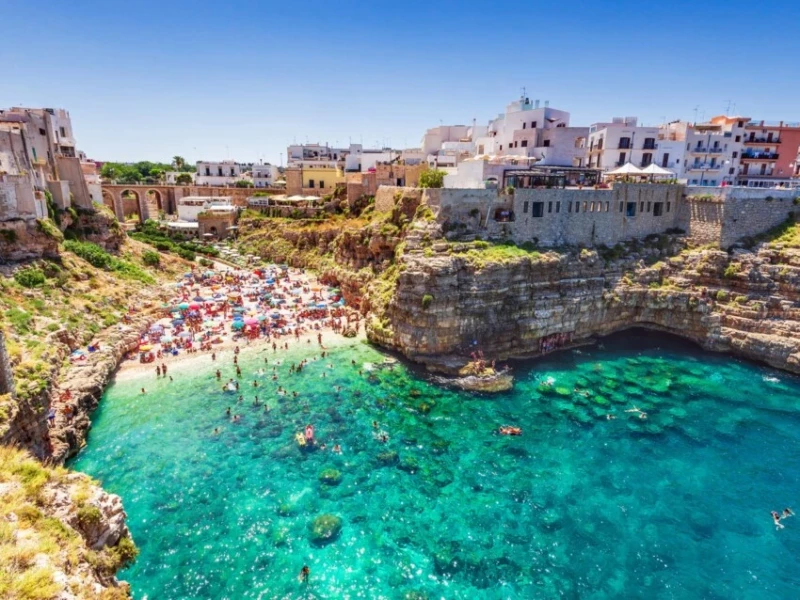
Polignano a Mare, nestled on the Adriatic coast of Puglia, is a picturesque destination that exudes natural beauty, ancient history, and Mediterranean charm. Here are some ideas for exploring Polignano a Mare with the theme of travel:
-
Cliffs and Sea Caves: Explore the spectacular limestone cliffs and sea caves along the coast of Polignano a Mare. Boat excursions will allow you to discover unique rock formations and admire the sea from a different perspective.
-
Old Town: Immerse yourself in the narrow streets of the old town, with its whitewashed houses and lively squares. The medieval architecture and panoramic views of the sea create a romantic and authentic atmosphere.
-
White-Sand Beaches: Relax on the white-sand beaches of Polignano a Mare, such as Cala Porto, where you can sunbathe and swim in the crystal-clear waters of the Adriatic.
-
Lama Monachile Bridge: Admire the Lama Monachile Bridge, an arched bridge overlooking the sea and connecting the old town to the new. It offers breathtaking views of the cliffs and the sea.
-
Piazza dell'Orologio: Visit the charming Piazza dell'Orologio, a central square surrounded by cafes, restaurants, and shops. It's the perfect place to unwind and enjoy the local atmosphere.
-
Local Gastronomy: Indulge in local cuisine at trattorias and restaurants in Polignano a Mare. Don't miss out on tasting fresh seafood dishes and the famous Italian gelato.
-
Sunset at Lama Monachile: End your day on a beautiful note by witnessing the sunset from the cliffs of Lama Monachile. It's a magical spectacle that paints the sky with warm hues and offers an unforgettable experience.
Polignano a Mare offers a captivating adventure where nature, culture, and cuisine harmoniously blend to create an unforgettable Mediterranean getaway.
 Our tips for getting the most out of your experience.
Our tips for getting the most out of your experience.
Exploring Polignano a Mare can be a delightful experience, filled with stunning coastal views, charming streets, and delicious local cuisine. Here are some tips to make the most of your visit to Polignano a Mare:
-
Wear Comfortable Shoes: The town is characterized by narrow streets and uneven terrain. Comfortable shoes are advisable for exploring the charming alleys and rocky coastal areas.
-
Explore Old Town in the Morning or Evening: The Old Town of Polignano a Mare is particularly enchanting in the early morning or evening when the narrow streets are quieter, and the soft light enhances the romantic atmosphere.
-
Visit the Beaches Early: If you plan to spend time on the beaches, consider going early in the day to secure a good spot. The beaches can get busier later in the day, especially during peak tourist seasons.
-
Take a Boat Tour: To appreciate the coastal beauty fully, consider taking a boat tour. This allows you to explore sea caves, admire the cliffs, and enjoy Polignano a Mare from a unique perspective.
-
Try Local Cuisine: Indulge in the local gastronomy. Polignano a Mare is known for its seafood, so be sure to try fresh fish dishes. Visit traditional restaurants and gelaterias to savor authentic Italian flavors.
-
Visit Lama Monachile Beach: Spend some time at Lama Monachile Beach, a picturesque spot with crystal-clear waters. You can relax on the pebbly beach and take in the views of the iconic bridge.
-
Attend Local Events: Check if there are any local events or festivals happening during your visit. This could provide an opportunity to experience the vibrant culture and traditions of the region.
-
Take in the Sunset: The sunset in Polignano a Mare is magical. Find a spot along the cliffs or on the beach to witness the sun setting over the Adriatic Sea. Lama Monachile is a popular spot for this.
-
Learn a Few Italian Phrases: While many locals may speak English, learning a few basic Italian phrases can enhance your experience and show appreciation for the local culture.
-
Respect Local Customs: Italians appreciate polite behavior. Respect local customs, such as saying "hello" and "thank you" in Italian, and embrace the relaxed pace of life.
-
Visit Off-Peak Seasons: Consider visiting during the off-peak seasons to avoid large crowds. Spring and fall are particularly pleasant times to explore Polignano a Mare.
-
Stay Overnight: To fully immerse yourself in the town's ambiance, consider staying overnight. The evening atmosphere is charming, and you can enjoy the peace and quiet after day-trippers have left.
By following these tips, you can make your visit to Polignano a Mare a memorable and enjoyable experience.
3 - Alberobello
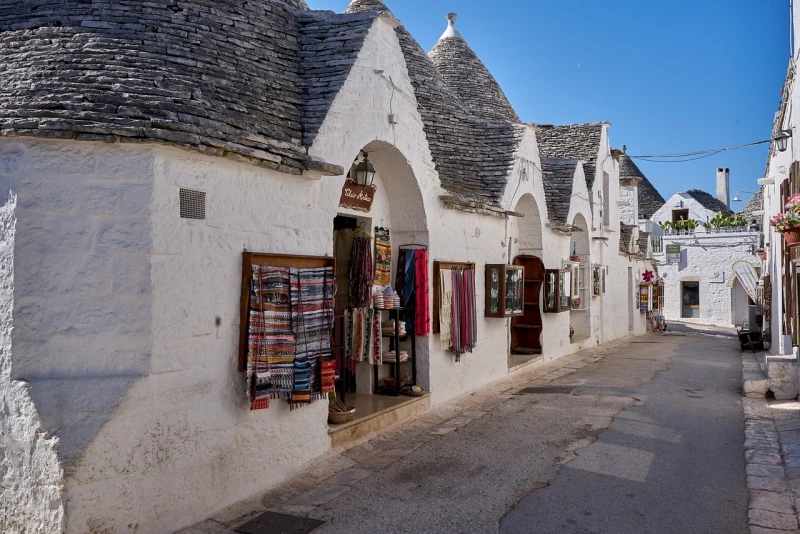
Alberobello, located in the Puglia region of Italy, is renowned for its trulli, distinctive stone houses with conical roofs. Here are some ideas for exploring Alberobello with the theme of travel:
-
Trulli Discovery: Alberobello is iconic for its unique trulli. Stroll through the Rione Monti and Aia Piccola neighborhoods to admire these whitewashed houses with cone-shaped stone roofs. Some have been converted into shops, cafes, or unique accommodations.
-
Territory Museum: Explore the Museo del Territorio, providing an in-depth look into the history and culture of the Puglia region, with a focus on the construction of trulli and traditional ways of life.
-
Guided Tour: Opt for a guided tour to learn more about the town's history, the construction techniques of trulli, and fascinating stories associated with these unique structures.
-
Rooftop Views: Climb to the top of the surrounding hills to enjoy panoramic views of Alberobello's trulli. It's an excellent opportunity to capture memorable photos of the picturesque architecture.
-
Trullo Market: Visit the Mercato del Trullo to discover local products, crafts, and souvenirs. It's a great place to purchase authentic items from Puglia.
-
Bike Ride in the Countryside: Explore the surrounding countryside of Alberobello by bike. This allows you to discover natural landscapes, olive groves, and vineyards while enjoying the Mediterranean weather.
Alberobello offers a captivating getaway where history, tradition, and architectural beauty combine to create an unforgettable travel experience.
 Our tips for getting the most out of your experience.
Our tips for getting the most out of your experience.
Exploring Alberobello, with its iconic trulli, can be a unique experience. Here are some tips to make the most of your visit:
-
Start Early in the Morning or Late Afternoon: To avoid crowds, consider visiting Alberobello early in the morning or late in the afternoon. This is often when the light is softer, creating an even more magical atmosphere.
-
Stroll on Foot through Trulli Districts: One of the pleasures of Alberobello is getting lost in the winding streets of its trulli districts. Explore on foot to discover hidden corners and capture unique photos.
-
Opt for a Guided Tour: For a better understanding of the history and cultural significance of the trulli, consider taking a guided tour. Local guides can share fascinating anecdotes about the architecture and daily life.
-
Visit Rione Monti and Aia Piccola Areas: These two neighborhoods are particularly rich in trulli. Rione Monti is often more touristy, while Aia Piccola offers a more authentic and tranquil atmosphere.
-
Consider Climate and Season: The best time to visit Alberobello is in spring (April-May) or autumn (September-October) when the weather is pleasant, and tourist numbers are lower.
-
Taste Local Specialties: Enjoy local cafes and restaurants to taste delicious specialties from Puglia. Pastas, olive oil products, cheeses, and local wines are must-tries.
-
Climb the Surrounding Hills: For a panoramic view of Alberobello and its trulli, climb the surrounding hills. Some points offer beautiful perspectives for photography enthusiasts.
-
Avoid Peak Hours: Tourist peak hours are usually in the middle of the day. Avoid these hours for a more peaceful experience, especially if you want to take photos undisturbed.
-
Attend a Local Event: Inquire about local events, such as festivals or markets, which can add a cultural dimension to your visit.
-
Respect Local Residents: Remember that trulli are often private residences. Be respectful and avoid disrupting the daily lives of the locals.
-
Overnight Stay in a Trullo: For an authentic experience, consider spending a night in a trullo converted into accommodation. This will give you the opportunity to live like a local in Alberobello, even if only for one night.
By following these tips, you can fully appreciate the unique magic and history of Alberobello.
4 - Monopoli
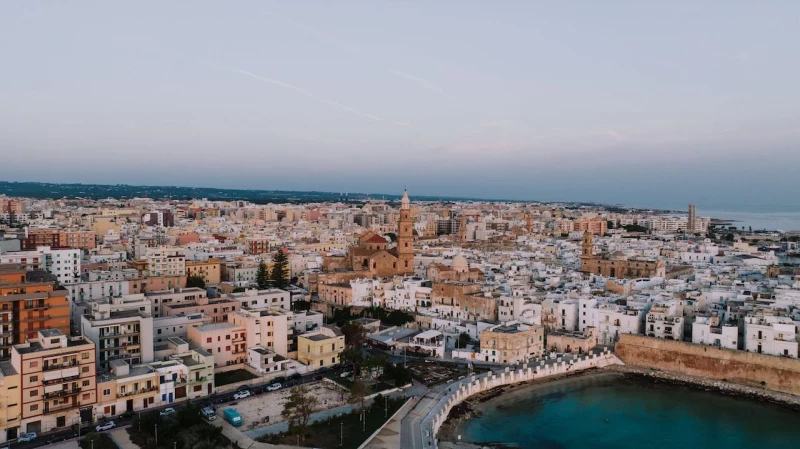
Monopoli, a charming coastal town in the Puglia region of Italy, offers a unique blend of history, culture, cuisine, and stunning coastal landscapes. Here are some ideas for exploring Monopoli with a travel theme:
-
Monopoli Old Town: Explore the narrow streets of Monopoli's Old Town, with its white stone buildings, historic churches, and picturesque squares. Don't miss the Charles V Castle and the Basilica of Madonna della Madia.
-
Monopoli Beaches: Enjoy the beaches of Monopoli, such as Cala Porta Vecchia, for sunbathing and swimming in the crystal-clear waters of the Adriatic Sea.
-
Monopoli Harbor: Stroll around the picturesque harbor, observe the colorful fishing boats, and choose one of the seafood restaurants to savor freshly prepared local dishes.
-
Charles V Castle: Visit the Charles V Castle, a historic fortress offering panoramic views of the sea. Explore its ramparts and discover its fascinating history.
-
Cuisine of Puglia: Taste the local cuisine of Puglia in Monopoli's trattorias and restaurants. Don't miss dishes featuring seafood, homemade pasta, and sweet delights like dolci.
-
Boat Excursion: Take a boat excursion along the coast to discover sea caves, secluded coves, and enjoy a panoramic view of the town from the sea.
-
Historic Churches: Visit Monopoli's historic churches, such as the Basilica of Madonna della Madia and the Cathedral of Maria Santissima della Madia, to admire religious and artistic architecture.
-
Nightlife: Explore the lively nightlife of Monopoli. Waterfront bars and cafes often provide a pleasant atmosphere to enjoy the evening.
-
Monopoli Market: Wander through the local market to discover fresh produce, spices, and handmade crafts. It's a great way to experience the daily life of the town.
-
Local Festivals: Inquire about local festivals and events that may take place during your visit. Local festivities can offer a unique insight into the culture and traditions of Monopoli.
-
Hiking along the Coast: Explore coastal trails that offer spectacular views of the Adriatic Sea. Hiking along the coast allows you to discover pristine natural landscapes.
-
Day Trip to Polignano a Mare: Monopoli is close to Polignano a Mare. Take advantage of a day to explore this neighboring town famous for its cliffs and sea caves.
Monopoli offers an authentic travel experience, blending history, culture, and Mediterranean pleasures along its sunny shores.
 Our tips for getting the most out of your experience.
Our tips for getting the most out of your experience.
Exploring Monopoli, the picturesque coastal town in Puglia, can be a delightful experience. Here are some tips to make the most of your visit:
-
Start with the Old Town: Begin your exploration in Monopoli's Old Town, where narrow streets exude charm. Deliberately get lost in its alleys to discover hidden corners and architectural gems.
-
Enjoy the Beaches: Monopoli offers several beaches, including Cala Porta Vecchia. If the weather permits, dedicate time to relaxation on the sand and swimming in the crystal-clear waters of the Adriatic Sea.
-
Discover the Harbor: Stroll around the picturesque fishing harbor. Admire the colorful boats and choose one of the restaurants to savor fresh seafood while enjoying the view of the sea.
-
Visit Charles V Castle: Explore Charles V Castle, a historic fortress offering panoramic views of the town and the sea. Climb the ramparts for an even more memorable experience.
-
Local Gastronomy: Taste the delicious cuisine of Puglia in local trattorias. Seafood specialties, fresh pasta, and traditional desserts are must-try delicacies.
-
Boat Excursion: Take a boat excursion along the coast to admire cliffs, sea caves, and coastal landscapes. It's a unique way to see Monopoli from the sea.
-
Explore Historic Churches: Visit Monopoli's historic churches, including the Basilica of Madonna della Madia. Appreciate the religious architecture and discover the cultural history of the town.
-
Nighttime Atmosphere: Enjoy the nighttime atmosphere. The squares and alleys of the Old Town come to life in the evening, offering a pleasant atmosphere for a stroll or outdoor dining.
-
Stroll Along the Waterfront: A walk along the waterfront provides stunning views of the sea and colorful buildings. It's also a great spot for a relaxing break.
-
Check the Event Calendar: Check if there are any local events or festivals during your stay. Participating in a local celebration can enhance your travel experience.
-
Relax in Parks and Gardens: Some parks and gardens offer pleasant green spaces for relaxation. Take advantage of the shade and tranquility for a peaceful break.
-
Day Trip to Polignano a Mare: If time allows, consider a day trip to Polignano a Mare, a neighboring town renowned for its spectacular cliffs.
By following these tips, you can fully appreciate the beauty and authenticity of Monopoli.
5 - Castel del Monte
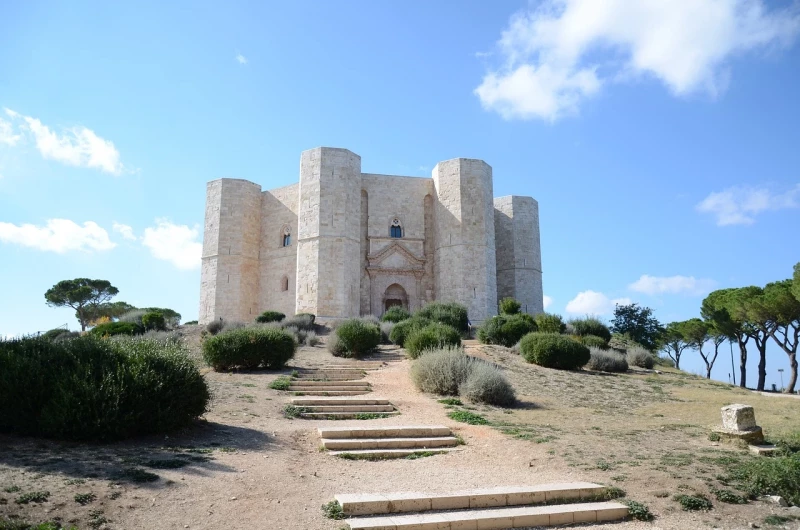
Castel del Monte is a medieval castle located in the Apulia region of southeastern Italy. It is situated on a hill near the town of Andria, in the province of Barletta-Andria-Trani. The castle is renowned for its unique and distinctive octagonal shape.
Here are some key features and information about Castel del Monte:
-
Architecture: The castle was built in the 13th century, between 1240 and 1250, during the reign of Holy Roman Emperor Frederick II. Its octagonal design is quite unusual for the time, and it features octagonal towers at each corner. The architecture combines elements of medieval, Renaissance, and classical styles.
-
Purpose: The exact purpose of Castel del Monte is still a subject of debate among historians. It doesn't seem to have served as a military fortress, and its location, away from major trade routes, raises questions about its strategic significance. Some theories suggest that it may have been a hunting lodge, a symbol of imperial power, or an astronomical observatory.
-
Symbolism: The castle is rich in symbolic elements, and the number eight (reflected in its octagonal shape) is thought to have symbolic significance, possibly related to numerology or the emperor's fascination with geometry and mathematics.
-
UNESCO World Heritage Site: Castel del Monte was designated as a UNESCO World Heritage Site in 1996. It is recognized for its unique architectural features and the historical significance associated with Frederick II.
-
Frederick II: The castle is closely linked to Holy Roman Emperor Frederick II, who was responsible for its construction. Frederick II was known for his patronage of the arts and sciences and was a prominent figure during the medieval period.
Visitors to the region can explore the castle, its interior rooms, and the panoramic views from its location. The site attracts tourists interested in medieval history, architecture, and the mysteries surrounding the purpose of this intriguing structure.
 Our tips for getting the most out of your experience.
Our tips for getting the most out of your experience.
If you're planning to visit Castel del Monte, here are some tips to enhance your experience:
-
Preparation: Before visiting, gather information about the history and architecture of the castle. This will enrich your experience by providing a better understanding of the historical context and architectural details.
-
Tour Guides: Consider hiring a tour guide if possible. A guide can offer in-depth information and anecdotes about the castle, making your visit more engaging and informative.
-
Opening Hours: Check the castle's opening hours before your visit. This will help you avoid unpleasant surprises and allow you to plan your day accordingly.
-
Avoid Peak Times: To steer clear of crowds, plan your visit during off-peak hours. Early mornings or late afternoons may be quieter times to explore.
-
Comfortable Shoes: Wear comfortable shoes as exploring the castle likely involves walking and navigating different parts of the site.
-
Camera: Don't forget to bring a camera. Castel del Monte offers stunning panoramic views, and the unique architecture of the castle is very photogenic.
-
Learn about Temporary Exhibitions: Check if there are any temporary exhibitions or special events happening during your visit. This can add an extra dimension to your experience.
-
Respect Site Rules: Follow the rules of the site, especially regarding photography, to preserve the integrity of the castle.
-
Explore Surroundings: Take advantage of your visit to explore the surrounding areas of the castle. The Puglia region offers other historical sites, beautiful countryside, and local traditions to discover.
-
Check Local Events: If you have extra time, inquire about local cultural events or festivals that might be taking place nearby. This could further enrich your stay in the region.
By following these tips, you should be well-prepared to fully enjoy your visit to Castel del Monte.
6 - Caves of Castellana
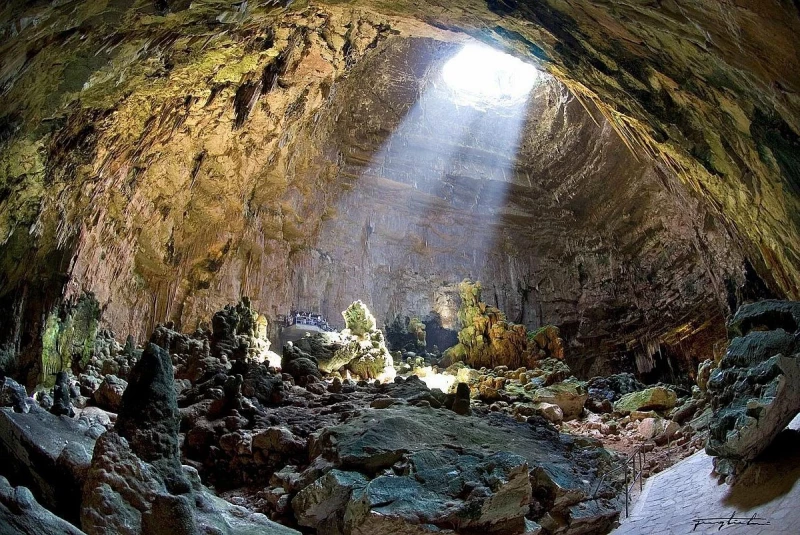
The Grotte di Castellana, or Grottos of Castellana in Italian, are a complex of limestone caves located near the town of Castellana Grotte in the Puglia region of southern Italy. Here are some key details about the Grotte di Castellana:
-
Formation: The caves were formed through millennia of water erosion on limestone rock. They are renowned for their spectacular karstic formations, including stalactites, stalagmites, columns, and other underground structures.
-
Guided Tours: Exploring the Grotte di Castellana is typically done on foot, with guided tours available in multiple languages. Guides provide detailed explanations about the geology of the caves, rock formations, and the history of the site.
-
Grotta Bianca and Grotta Nera: The caves consist of several sections, with Grotta Bianca (White Cave) and Grotta Nera (Black Cave) among the most impressive. Grotta Bianca is characterized by white crystalline formations, while Grotta Nera features darker and more imposing formations.
-
Underground Complex: The Grotte di Castellana form an extensive underground complex with rooms, corridors, and natural cavities. The tour allows you to explore a portion of this geological wonder.
-
Special Events: Occasionally, special events, concerts, or theatrical performances take place in the caves, taking advantage of the unique acoustics of the underground environment.
-
Opening Hours: Check the opening hours and availability of guided tours before planning your visit.
-
Attire: Wear comfortable and suitable footwear for underground walking. The temperature inside the caves is constant, but it's advisable to bring a light jacket.
-
Photography: Check the photography rules during the tour, as in some cases, the use of flash may be prohibited to preserve the natural formations.
The Grotte di Castellana offer a unique experience for geology enthusiasts, nature lovers, and those seeking underground adventure. The tour takes you through amazing subterranean landscapes, providing a fascinating insight into the formation of limestone caves over time.
 Our tips for getting the most out of your experience.
Our tips for getting the most out of your experience.
If you're planning to visit the Grotte di Castellana, here are some tips to enhance your experience:
-
Book in Advance: If possible, book your tickets online or in advance. This can save you time upon arrival and ensure you have a spot for the tour.
-
Choose the Right Time of Day: The caves may be quieter early in the morning or late in the afternoon. Try to avoid peak hours for a more peaceful experience.
-
Guided Tour: Opt for a guided tour. Guides provide in-depth information on the geology, history, and features of the caves, enhancing your overall experience.
-
Check Opening Hours: Make sure to check the opening hours and the schedule for guided tours to plan your visit optimally.
-
Appropriate Attire: Wear comfortable and suitable shoes for walking, as the tour often involves walking through the caves.
-
Prepare for Constant Temperature: The caves have a constant temperature, but it's a good idea to bring a light jacket as it can be cooler inside.
-
Respect Tour Rules: Follow the rules of the tour to preserve the natural rock formations. This may include guidelines on photography and behavior inside the caves.
-
Photography Equipment: If you plan to take photos, ensure your equipment is suitable for low-light conditions. In some caves, the use of flash may be restricted.
-
Check for Special Events: See if there are any special events or temporary exhibitions in the caves during your visit. This could add an extra dimension to your experience.
-
Explore the Surroundings: Take advantage of your visit to explore the surroundings of Castellana Grotte. The region offers other attractions, local cuisine, and an authentic atmosphere to discover.
By following these tips, you should be well-prepared to fully enjoy your visit to the Grotte di Castellana.
7 - Ostuni the white city
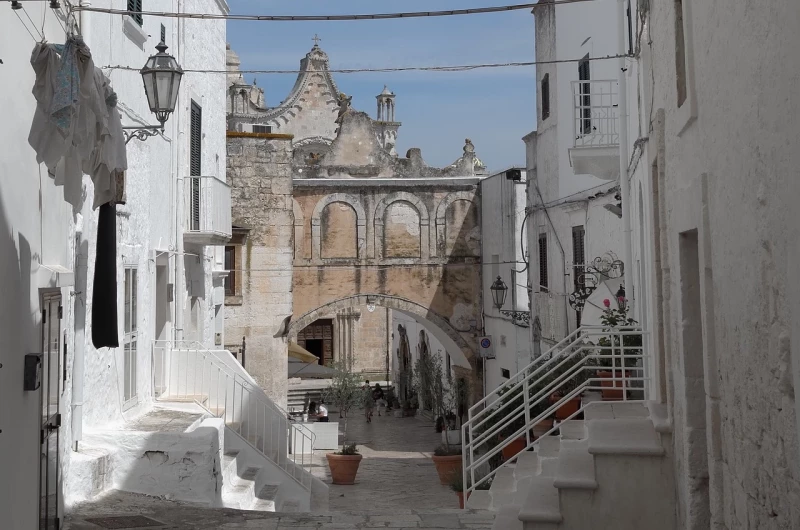
Ostuni, often referred to as "The White City" (La Città Bianca), is a stunning hilltop town located in the region of Puglia, Italy. Here are some key points about Ostuni:
-
Architectural Beauty: Ostuni is known for its striking white-washed buildings, narrow winding streets, and traditional southern Italian architecture. The use of white lime wash gives the city its characteristic appearance, and the effect is particularly enchanting when illuminated by the sunlight.
-
Location: Situated on a hill about 8 kilometers from the Adriatic Sea, Ostuni offers panoramic views of the surrounding countryside and the coastline. The town's elevated position has historically provided defensive advantages.
-
Historical Significance: The origins of Ostuni date back to the Roman period, and it has a rich history marked by various influences, including Byzantine, Norman, and Aragonese. The historic center is a maze of charming alleys and squares with notable landmarks such as the Cathedral of Ostuni (Cattedrale di Ostuni) and the Bishop's Palace.
-
Cathedral of Ostuni: The cathedral, dedicated to the Assumption of the Virgin Mary, is a prominent landmark. It features a beautiful rose window and impressive architecture, and its interior is adorned with intricate decorations.
-
Local Cuisine: Ostuni is known for its delicious local cuisine, which includes fresh seafood, olive oil, and Puglian specialties. Exploring the local restaurants and trattorias is a must for food enthusiasts.
-
Events and Festivals: Ostuni hosts various events and festivals throughout the year. The Cavalcata di Sant'Oronzo, a traditional horse parade, is one of the notable celebrations.
-
Olive Oil Production: The surrounding countryside is dotted with olive groves, and Ostuni is part of the region known for its high-quality olive oil. Visitors can explore local olive oil mills and learn about the production process.
-
Tourist Attractions: Apart from the cathedral, Ostuni has other attractions like the Aragonese Castle and the Church of San Francesco. Exploring the town on foot is a rewarding experience, discovering hidden corners and picturesque views.
-
Tourism: Ostuni has become a popular tourist destination, attracting visitors with its unique charm, historical significance, and panoramic vistas. The town offers a blend of cultural exploration, culinary delights, and a relaxed Mediterranean atmosphere.
Whether you're interested in history, architecture, or simply enjoying the ambiance of a traditional Italian town, Ostuni has much to offer.
 Our tips for getting the most out of your experience.
Our tips for getting the most out of your experience.
If you're planning to visit Ostuni, here are some tips to enhance your experience:
-
Explore on Foot: Ostuni is a city best explored on foot, with its narrow streets and charming squares. Wear comfortable shoes to navigate the cobblestone streets easily.
-
Visit the Cathedral Early in the Morning: If possible, visit the Ostuni Cathedral early in the morning to avoid crowds and enjoy the serenity of the place.
-
Discover the Historic Center: Get lost in Ostuni's historic center, where every corner reveals interesting architectural details, artisanal shops, and picturesque cafes.
-
Enjoy Panoramic Views: Climb to the top of the old town to enjoy panoramic views of the surrounding countryside and the sea. The viewpoints from the city walls offer spectacular panoramas.
-
Taste Local Cuisine: Ostuni is renowned for its local cuisine. Enjoy local restaurants and trattorias to savor typical Apulian dishes, such as orecchiette pasta, fresh seafood, and local olive oil.
-
Attend a Local Event: Inquire about local events or festivals that might take place during your visit. This could add a cultural and festive dimension to your stay.
-
Explore the Surroundings: If you have time, explore the surroundings of Ostuni, including the beaches along the Adriatic coast and nearby towns like Alberobello with its characteristic trulli.
-
Book in Advance for Special Tours: If special tours, such as night tours or guided excursions, are available, consider booking in advance to secure your spot.
-
Visit the Aragonese Castle: Don't miss a visit to the Aragonese Castle, which provides another interesting perspective on Ostuni's history.
-
Learn about Local History: Before your visit, learn about the history and culture of Ostuni. This will enhance your experience by better understanding the sites you'll be visiting.
By following these tips, you'll be better prepared to fully enjoy your visit to Ostuni and discover everything that this beautiful town in Puglia has to offer.
8 - Lecce
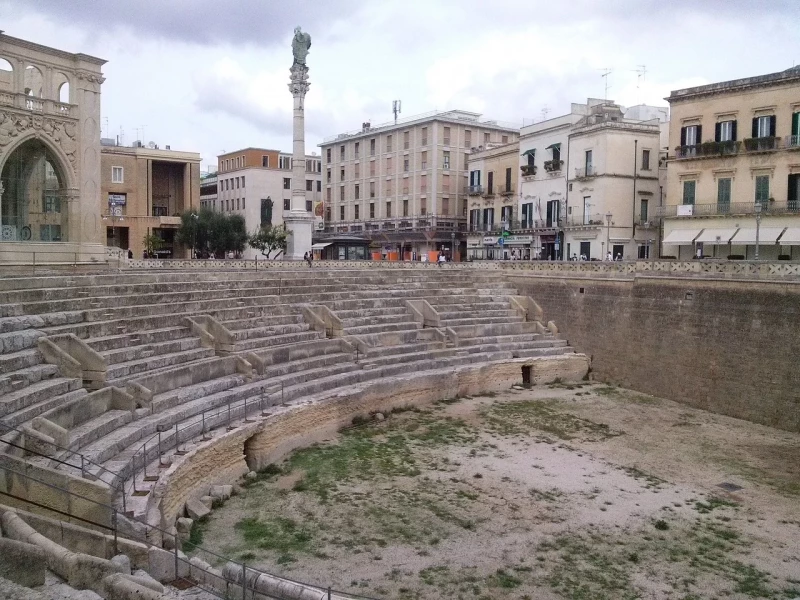
Lecce is a historic city located in the Apulia (Puglia) region of southern Italy. Here are some key points about Lecce:
-
Baroque Architecture: Lecce is often referred to as the "Florence of the South" due to its rich Baroque architecture. The city is known for its elaborate and ornate buildings, churches, and monuments, characterized by intricate carvings and decorative details.
-
Historical Significance: The history of Lecce dates back to ancient times, and its architecture reflects a mix of influences, including Roman, Greek, and Norman. The city flourished during the Baroque period in the 17th century, leaving a lasting imprint on its urban landscape.
-
Piazza del Duomo: The central square, Piazza del Duomo, is a focal point in Lecce and is surrounded by important landmarks such as the Lecce Cathedral (Duomo di Lecce), the Bishop's Palace, and the Campanile.
-
Lecce Cathedral (Duomo di Lecce): The cathedral is dedicated to the Assumption of the Virgin Mary and showcases the distinctive Lecce Baroque style. It features a rose window and a stunning façade adorned with intricate sculptures.
-
Roman Amphitheatre: Lecce boasts a well-preserved Roman amphitheater, which was built in the 2nd century and could accommodate thousands of spectators. It is a testament to the city's ancient Roman heritage.
-
Santa Croce Basilica: This Baroque church is a masterpiece of Lecce's architecture, featuring a highly decorated façade with detailed sculptures and reliefs.
-
Palazzo dei Celestini: A former monastery, this building now serves as a government seat. It displays a mix of architectural styles, including Gothic and Baroque elements.
-
Local Cuisine: Lecce offers a rich culinary experience with traditional Apulian dishes. Local specialties include pasticciotto (a pastry filled with custard), orecchiette pasta, and regional wines.
-
Craftsmanship: Lecce is known for its skilled craftsmen who work with local limestone, creating intricate carvings and sculptures. Visitors can find unique souvenirs and decorative items made from this distinctive stone.
-
Festivals and Events: Lecce hosts various cultural events and festivals throughout the year, celebrating music, arts, and traditions. The city comes alive during these festivities, providing a vibrant atmosphere.
Lecce is a city that captivates visitors with its artistic and historical richness, making it a must-visit destination for those interested in architecture, history, and the charm of southern Italy.
 Our tips for getting the most out of your experience.
Our tips for getting the most out of your experience.
If you're planning to visit Lecce, here are some tips to make your stay more enjoyable:
-
Stroll through the Historic Center: Lecce boasts a historic center rich in Baroque architecture. Explore its picturesque streets, discover charming squares, and immerse yourself in the unique atmosphere.
-
Visit Piazza del Duomo: The central square, Piazza del Duomo, is surrounded by impressive monuments such as the cathedral, the bell tower, and the Episcopal Palace. It's an ideal starting point for exploring the city.
-
Admire Lecce Cathedral (Duomo di Lecce): Don't miss the Baroque cathedral dedicated to the Assumption of the Virgin Mary. Its elaborate architecture and sculptural details are worth a visit.
-
Explore the Roman Amphitheatre: Discover the well-preserved Roman amphitheater in the heart of the city. It provides a glimpse into Lecce's Roman past.
-
Indulge in Local Cuisine: Enjoy the rich cuisine of Puglia in local trattorias. Try specialties like orecchiette pasta, puccia (local bread), and dishes featuring local olive oil.
-
Visit Basilica Santa Croce: Explore the Basilica Santa Croce, a dazzling example of Lecce's Baroque architecture, with its ornate façade and detailed sculptures.
-
Participate in Local Festivals: Inquire about events and festivals taking place during your visit. Local festivals often feature artistic performances, music, and lively celebrations.
-
Discover Local Craftsmanship: Lecce is renowned for its stone carving. Explore craft shops to purchase unique souvenirs carved from local stone.
-
Enjoy the Nightlife: Lecce offers vibrant nightlife, especially during the summer season. Bars and cafes on the squares often turn into lively places in the evening.
-
Plan Day Trips: If time allows, consider day trips to nearby attractions, including the beaches of the Adriatic coast or other towns in Puglia.
By following these tips, you'll be able to fully enjoy your visit to Lecce, exploring its history, culture, and delightful local cuisine.
9 - Brindisi
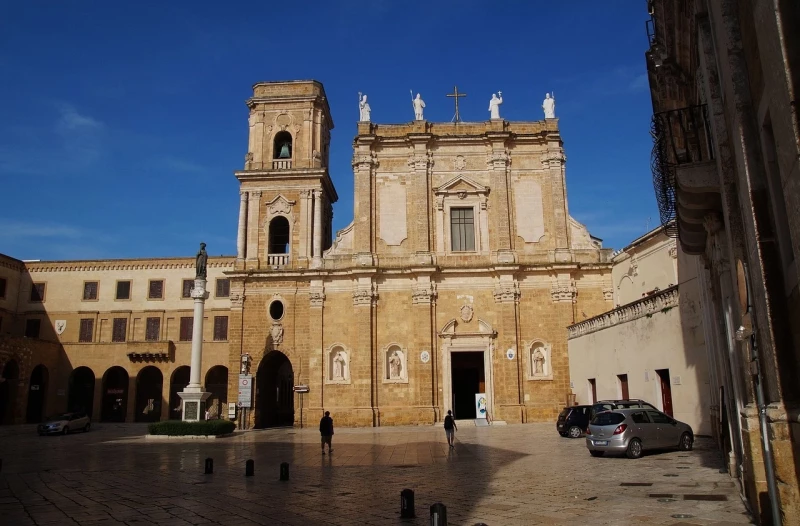
Brindisi is a port city located in the Apulia (Puglia) region of southern Italy. Here are some key points about Brindisi:
-
Historical Significance: Brindisi has a rich history dating back to ancient times. It was an important port in Roman times, serving as the endpoint of the famous Via Appia road.
-
Port of Brindisi: The city's port has played a crucial role throughout history, serving as a gateway for trade and military activities. Today, it continues to be an active commercial and passenger port.
-
Monuments and Landmarks: Brindisi is home to several historical monuments and landmarks. The Castello Svevo (Swabian Castle) is a medieval fortress that offers panoramic views of the city and the harbor. The Roman Column (Colonna Romana) is another notable landmark.
-
Romanesque Cathedral: The Cathedral of Brindisi, dedicated to Saint John the Baptist, is a Romanesque-style church with elements dating back to the 11th century.
-
Church of Santa Maria del Casale: This church is renowned for its medieval frescoes depicting biblical scenes and is considered an excellent example of Apulian Romanesque architecture.
-
Archaeological Sites: Brindisi has archaeological sites that reflect its ancient history. The Roman Forum and the Roman Columns are among the notable sites.
-
Waterfront Promenade: Enjoy a stroll along the waterfront promenade, Lungomare Regina Margherita, which offers scenic views of the Adriatic Sea and the city's coastline.
-
Local Cuisine: Brindisi, like the rest of the Puglia region, is known for its delicious cuisine. Fresh seafood, olive oil, and local wines are staples of the local gastronomy.
-
Swabian Castle Museums: The Swabian Castle houses museums, including the Provincial Archaeological Museum and the Museo del Mare (Museum of the Sea), providing insights into the region's history and maritime heritage.
-
Events and Festivals: Brindisi hosts various events and festivals throughout the year, celebrating local traditions, music, and cultural heritage.
-
Gateway to Greece: Due to its strategic location, Brindisi has historically been a departure point for ferry services to Greece, making it a transit hub for travelers.
Whether you're interested in history, seaside views, or local cuisine, Brindisi offers a blend of cultural richness and Mediterranean charm.
 Our tips for getting the most out of your experience.
Our tips for getting the most out of your experience.
If you're planning to visit Brindisi, here are some tips to enhance your experience:
-
Explore the Historic Center: Take a stroll through the historic center of Brindisi to discover its narrow streets, lively squares, and charming architecture. Piazza Duomo is a good starting point.
-
Visit Castello Svevo: Explore Castello Svevo, a medieval fortress that offers panoramic views of the city and the port. It's an ideal place to delve into the history of Brindisi.
-
Walk Along Lungomare: Enjoy a walk along Lungomare Regina Margherita, the seaside promenade, to admire the view of the Adriatic Sea and appreciate the maritime breeze.
-
Discover Brindisi Cathedral: Visit the Romanesque cathedral dedicated to Saint John the Baptist. Admire its architecture, frescoes, and the spiritual atmosphere.
-
Explore Santa Maria del Casale Church: Don't miss Santa Maria del Casale Church, known for its medieval frescoes. It's a fascinating artistic testament.
-
Take a Harbor Cruise: Consider taking a short cruise in the port for a different perspective of the city from the sea.
-
Indulge in Local Cuisine: Explore local restaurants to taste delicious Apulian cuisine. Fresh seafood, local pasta, and regional wines are must-try items.
-
Visit Castle Museums: Explore the museums within Castello Svevo, such as the Provincial Archaeological Museum and the Museum of the Sea, to learn more about local history and culture.
-
Attend Local Events: Inquire about events and festivals happening during your visit. Local festivities often offer an interesting cultural immersion.
-
Day Trip Opportunities: Take advantage of Brindisi's strategic location to embark on day trips to nearby destinations such as Lecce, Ostuni, or Alberobello.
-
Explore Ancient History: Visit Brindisi's archaeological sites, including the Roman Forum and Roman Columns, for a glimpse into the ancient history of the region.
By following these tips, you'll be able to fully enjoy your visit to Brindisi, uncovering its heritage, savoring its cuisine, and experiencing its maritime ambiance.
10 - Gargano National Park
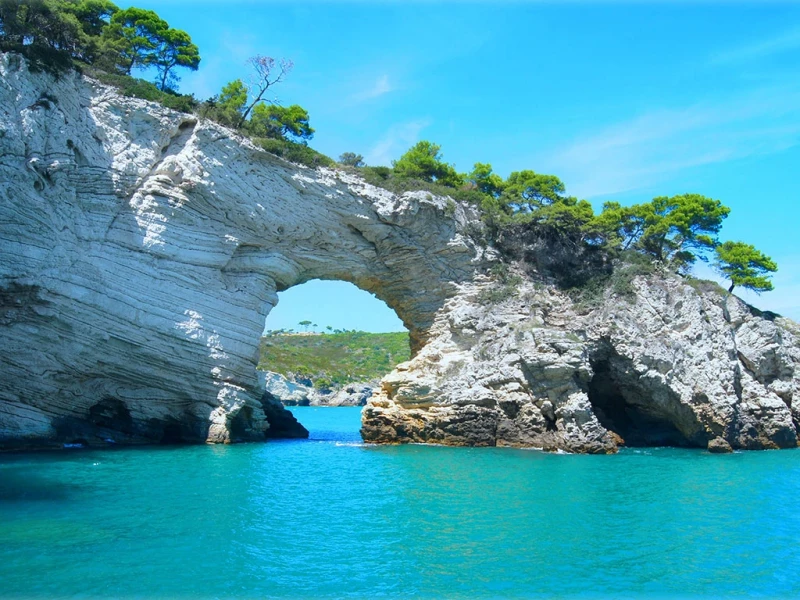
Gargano National Park is a protected area located in the Gargano Peninsula in the northern part of the Apulia (Puglia) region in southern Italy. Here are some key points about Gargano National Park:
-
Geography: The Gargano Peninsula is characterized by its diverse and scenic landscapes, including lush forests, coastal cliffs, sandy beaches, and picturesque coastal towns.
-
Monte Gargano: The park is centered around Monte Gargano, a limestone massif that rises abruptly from the surrounding plains. The mountain is home to rich biodiversity, including various plant and animal species.
-
Forest Cover: Gargano National Park is known for its dense forests, primarily composed of beech and oak trees. The Forest Umbra, located on the slopes of Monte Gargano, is particularly noteworthy for its natural beauty.
-
Flora and Fauna: The park is home to a variety of plant and animal species, some of which are unique to the Gargano Peninsula. The diverse ecosystems support a range of wildlife, including birds of prey, deer, wild boars, and several endemic plant species.
-
Valli Cupe: Valli Cupe, meaning "deep valleys," is a network of deep canyons and gorges carved by rivers through the limestone rocks. The landscapes are striking, offering opportunities for hiking and exploration.
-
Coastline: The Gargano Peninsula features a dramatic and varied coastline with high cliffs, secluded coves, and sandy beaches. The sea caves and crystal-clear waters along the coast contribute to the region's natural beauty.
-
Vieste and Mattinata: The park includes charming coastal towns, such as Vieste and Mattinata, which are popular tourist destinations. Vieste is known for its historic center, medieval architecture, and the iconic Pizzomunno sea stack.
-
Religious Sites: Monte Sant'Angelo, located within the park, is home to the Sanctuary of Monte Sant'Angelo, an important pilgrimage site. The sanctuary is dedicated to the Archangel Michael and has historical and religious significance.
-
Outdoor Activities: Gargano National Park offers various outdoor activities, including hiking, bird-watching, and water sports. There are numerous trails for exploring the diverse landscapes of the park.
-
Cultural Heritage: In addition to its natural beauty, the Gargano region has a rich cultural heritage with historical sites, traditional architecture, and local traditions.
Visiting Gargano National Park provides an opportunity to immerse yourself in nature, explore diverse landscapes, and experience the cultural richness of this unique part of Italy.
 Our tips for getting the most out of your experience.
Our tips for getting the most out of your experience.
If you're planning to visit Gargano National Park, here are some tips to make your stay more enjoyable:
-
Choose the Right Season: Spring and autumn are ideal seasons to visit Gargano. The weather is pleasant, and nature is at its peak, offering lush and colorful landscapes.
-
Explore Hiking Trails: The park offers numerous hiking trails with a variety of landscapes. Research available routes, their difficulty levels, and points of interest along the way.
-
Discover Foresta Umbra: Foresta Umbra is a dense forest on the slopes of Monte Gargano. Explore its shaded trails to discover a variety of flora and fauna, including some endemic species.
-
Visit Valli Cupe: Explore Valli Cupe, the deep valleys of Gargano, to experience spectacular landscapes. These canyons offer unique opportunities for hiking enthusiasts.
-
Explore Vieste and Mattinata: The coastal towns of Vieste and Mattinata are gems in Gargano. Enjoy the beaches, explore the historic centers, and savor local cuisine.
-
Monte Sant'Angelo and its Sanctuary: Monte Sant'Angelo is home to the famous Sanctuary of Monte Sant'Angelo, an important pilgrimage site. Explore this religious site and enjoy panoramic views.
-
Participate in Water Activities: Take advantage of the crystal-clear waters of the Gargano coast by engaging in water activities such as scuba diving, sailing, or kayaking.
-
Respect the Environment: The park is a natural reserve, so be respectful of the environment. Stick to marked trails, avoid littering, and refrain from disturbing wildlife.
-
Taste Local Cuisine: Sample the delicious cuisine of Apulia. Look for local restaurants to taste dishes made with fresh produce, including seafood, pasta, and local cheeses.
-
Learn about Local Events: Inquire about local events and festivals that may take place during your stay. This can add a cultural dimension to your experience.
-
Accommodation: Choose accommodations that offer an authentic experience, such as agriturismi (farm stays) located in the Gargano region.
By following these tips, you can fully enjoy the natural beauty, outdoor activities, and culture of Gargano National Park during your visit.
11 - Matera
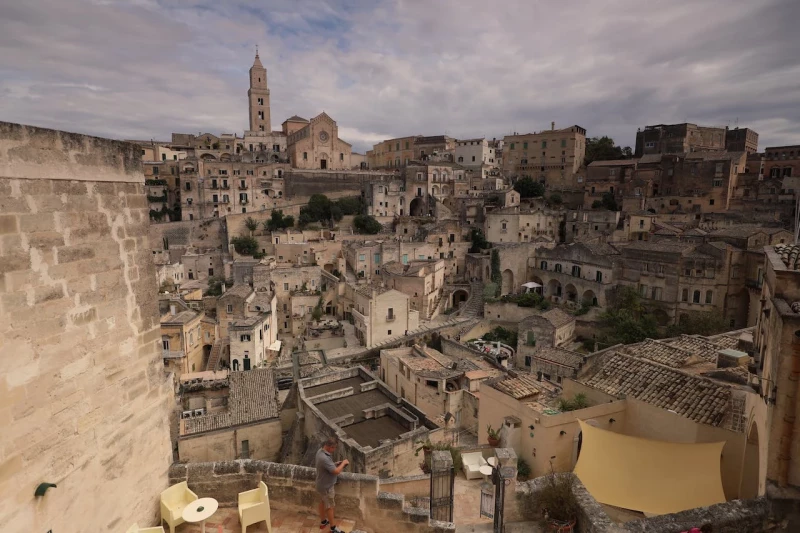
Matera is a unique and historic city located in the Basilicata region of southern Italy. Here are some key points about Matera:
-
Sassi di Matera: Matera is renowned for its ancient cave dwellings, known as the "Sassi di Matera." These cave dwellings, carved into limestone rock, are considered one of the earliest examples of human settlements in Italy. The Sassi have been designated as a UNESCO World Heritage Site.
-
Cave Dwellings: The Sassi are characterized by cave-like structures with rooms and passages carved into the soft rock. These dwellings were inhabited for centuries and have a fascinating history.
-
Historic Center: Matera's historic center is divided into two areas: Sasso Caveoso and Sasso Barisano. Both areas offer a maze of narrow streets, alleys, and staircases, creating a unique and captivating urban landscape.
-
Churches and Rock-Cut Architecture: Matera is home to numerous churches carved into the rock, displaying remarkable frescoes and rock-cut architecture. Notable churches include the Church of San Pietro Caveoso and the Church of San Francesco d'Assisi.
-
Casa Grotta di Vico Solitario: This cave dwelling has been preserved to showcase how families lived in Matera's Sassi in the past. It provides insights into the traditional way of life in the city.
-
Matera Cathedral (Cattedrale di Matera): The cathedral is located on the Civita hill and features a mix of architectural styles, including Romanesque and Apulian Gothic. The cathedral offers panoramic views of the surrounding landscape.
-
Palombaro Lungo: This is an underground water cistern in Matera, one of the largest in the city. It was used to collect and store rainwater for the community.
-
Museums: Matera has several museums that provide a deeper understanding of the city's history, including the National Archaeological Museum "Domenico Ridola" and the Museum of Contemporary Sculpture "MUSMA."
Matera's unique architecture and rich history make it a captivating destination, attracting visitors from around the world who are drawn to its distinctive charm and cultural significance.
 Our tips for getting the most out of your experience.
Our tips for getting the most out of your experience.
If you're planning to visit Matera, here are some tips to enhance your experience in this fascinating city:
-
Explore the Sassi at Sunrise or Sunset: The Sassi, Matera's ancient cave dwellings, take on a stunning golden hue at sunrise and sunset. Explore these labyrinthine alleys during these times for an even more picturesque experience.
-
Visit Casa Grotta di Vico Solitario: This preserved cave dwelling provides an authentic glimpse into daily life in the Sassi. It showcases period furniture and traditional tools.
-
Take a Guided Tour: Local guides can provide in-depth information about Matera's history and architecture. A guided tour can help you uncover details you might otherwise miss.
-
Climb to Matera Cathedral: Matera Cathedral offers a breathtaking view of the city. Climb up to Civita hill for a panoramic outlook over the Sassi and the surrounding area.
-
Explore Rock-Cut Churches: Matera is home to numerous churches carved into the rock, featuring fascinating frescoes. Don't miss San Pietro Caveoso and San Francesco d'Assisi churches.
-
Discover MUSMA Museum: The Museum of Contemporary Sculpture (MUSMA) is located in a former rock-cut church. Explore contemporary artworks displayed in a unique setting.
-
Attend a Cultural Event: Inquire about cultural events or festivals happening during your stay. Matera regularly hosts artistic and musical events.
-
Taste Local Cuisine: Enjoy delicious local cuisine. Look for trattorias and restaurants offering traditional dishes from Apulia, such as pasta con i peperoni cruschi.
-
Wander Through Alleys Without a Set Itinerary: Deliberately get lost in the winding alleys of the Sassi. This allows you to discover hidden corners and capture the authentic essence of the city.
-
Book in Advance for Popular Tours: If you plan to visit popular sites or specific guided tours, consider booking in advance, especially during the peak tourist season.
-
Respect the Environment: Matera is a UNESCO World Heritage site, so make sure to respect the environment. Follow rules, avoid littering, and be mindful of preserving the site.
By following these tips, you'll be able to fully enjoy your visit to Matera and uncover everything this unique city has to offer in terms of history, culture, and architectural charm.
12 - Les îles Tremiti
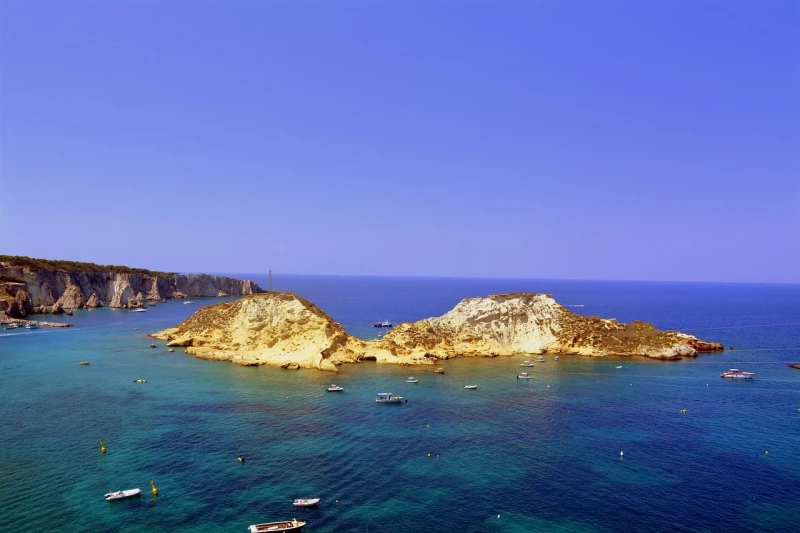
The Tremiti Islands, also known as the Diomede Islands, are a small archipelago located in the Adriatic Sea, off the coast of the Gargano Peninsula in the Apulia region of southeastern Italy. Here are some key points about the Tremiti Islands:
-
Composition: The Tremiti archipelago consists of five main islands: San Domino, San Nicola, Capraia, Cretaccio, and Pianosa, along with several smaller islets.
-
San Domino: This is the largest and most visited of the Tremiti Islands. It is known for its sandy beaches and crystal-clear waters. San Domino is covered with pine forests and offers picturesque hiking trails.
-
San Nicola: This island is home to the historical center of the Tremiti Islands, featuring the monastery of San Nicola, an important historical and religious site. The island provides panoramic views of the sea.
-
Capraia: Capraia is the furthest of the main islands and is often visited for its sea caves and spectacular rock formations.
-
Cretaccio and Pianosa: These smaller islands are generally not permanently inhabited. Cretaccio is mainly a limestone rock, while Pianosa is a small expanse of land with minimal vegetation.
-
History: The Tremiti Islands have a rich history and have been used at various times for activities such as monasticism, coastal defense, and even as a place of exile for historical figures.
-
Monastery of San Nicola: The monastery of San Nicola on the island of the same name is an important site dating back to the 11th century. It is dedicated to Saint Nicholas and is built in a characteristic architectural style.
-
Activities: The Tremiti Islands offer activities such as scuba diving, sailing, hiking, and exploring sea caves. The area is also renowned for its diverse marine life.
-
Access: The Tremiti Islands are accessible by ferry from the port of Termoli on the Italian coast. The ferry ride provides beautiful views of the Adriatic Sea.
-
Marine Reserve: The region around the Tremiti Islands has been designated a marine reserve, protecting the biodiversity of its underwater ecosystems.
The Tremiti Islands are an ideal destination for those seeking spectacular marine landscapes, outdoor activities, and a tranquil getaway away from the Italian mainland.
 Our tips for getting the most out of your experience.
Our tips for getting the most out of your experience.
If you're planning to visit the Tremiti Islands, here are some tips to make your trip more enjoyable:
-
Plan Your Journey: Check ferry schedules from the port of Termoli, which is one of the main departure points for the Tremiti Islands. Make sure to book your tickets in advance, especially during the high season.
-
Choose the Island Suited to Your Interests: Each island has its own characteristics. San Domino is ideal for beaches and nature, San Nicola for history and culture, and Capraia for exploring sea caves. Choose based on your preferences.
-
Explore Sea Caves: The Tremiti Islands offer fascinating sea caves. Opt for a boat excursion to explore these spectacular rock formations and discover marine life.
-
Hike on San Domino: Enjoy hiking trails on the island of San Domino, providing panoramic views of the Adriatic Sea. Don't forget to bring comfortable walking shoes.
-
Visit the Monastery of San Nicola: On the island of San Nicola, explore the historic Monastery of San Nicola, offering insight into the religious history of the region.
-
Participate in Water Activities: If you enjoy scuba diving, bring your gear or consider participating in activities organized by local diving centers. The crystal-clear waters are ideal for exploring marine life.
-
Enjoy Local Cuisine: Taste local cuisine, especially seafood dishes. Look for restaurants offering local specialties, and be sure to try fresh seafood.
-
Respect the Environment: The Tremiti Islands are a preserved natural site. Be respectful of the environment by sticking to marked trails, avoiding littering, and not disturbing marine life.
-
Inquire about Local Events: Find out about local events or festivals that may take place during your stay. This could add a cultural dimension to your visit.
-
Be Flexible with Your Schedule: The Tremiti Islands are an ideal place to relax. Be flexible with your schedule and take time to appreciate the natural beauty of the archipelago.
By following these tips, you can fully enjoy your visit to the Tremiti Islands and explore the natural and cultural diversity of this beautiful archipelago.
Puglia - Where to Stay?
Choosing where to stay in Puglia depends on your preferences, budget, and the type of experience you're seeking. Here are some suggestions on places to stay in Puglia:
-
Bari: As the capital of Puglia, Bari offers a variety of accommodation options, from modern hotels to traditional bed and breakfasts. It's an excellent starting point for exploring the region, especially if you arrive by plane.
-
Alberobello: Famous for its trulli, conical stone houses, Alberobello provides unique accommodations in renovated trulli for an authentic experience.
-
Ostuni: Known as the "White City" due to its whitewashed buildings, Ostuni offers a picturesque atmosphere. You can find charming hotels in the heart of the old town.
-
Lecce: Renowned for its baroque architecture, Lecce features elegant hotels and charming accommodations nestled within historic alleys.
-
Polignano a Mare: This picturesque coastal town is renowned for its cliffs and sea caves. You can find accommodations with sea views for a relaxing experience.
-
Monopoli: Another beautiful coastal town, Monopoli, offers an authentic atmosphere with narrow streets and lively squares. Historic hotels and vacation rentals are available.
-
Matera: Although technically located in Basilicata, Matera is close to Puglia and is famous for its cave dwellings. Staying in a charming hotel carved into the rock provides a unique experience.
-
Gargano National Park: For a nature immersion, Gargano National Park offers accommodations in agriturismi (farm stays) and bed and breakfasts surrounded by green landscapes.
Ensure to book in advance, especially during the high tourist season, to secure the best rates and availability. Explore online reviews to find accommodation that best suits your needs and travel style.
Puglia - How to get around?
Getting around Puglia can be done in various ways depending on your itinerary and preferences. Here are some common means of transportation in the region:
-
Rental Car: Renting a car is often the most convenient way to explore Puglia, especially if you plan to visit less accessible places. Roads are generally well-maintained, and a car provides the freedom to discover the region at your own pace.
-
Train: The railway network connects several cities in Puglia, including Bari, Lecce, Brindisi, and others. Trains offer an efficient way to travel between major destinations, but some more remote sites may require alternative transportation.
-
Bus: Regional buses serve many towns and villages in Puglia. However, schedules may be less frequent, especially in rural areas, so be sure to check the timetables in advance.
-
Bicycle: Puglia's beautiful landscapes make cycling an excellent option, especially in coastal areas or through olive groves. Some places also offer bike rentals.
-
Boat: Being a coastal region, traveling by boat can be an option, especially for visiting islands and exploring the coastline. Boat excursions can also be organized to discover sea caves and secluded beaches.
-
Taxi: Taxis are available in major cities but may be harder to find in more rural areas. It's advisable to book in advance.
-
Walking: In the historic centers of cities like Lecce, Bari, or Ostuni, walking is often the best way to explore picturesque alleyways and historical sites.
Before traveling, it's always recommended to check transportation schedules and plan accordingly based on your specific itinerary and the places you want to visit.
Puglia - Best period
The best time to visit Puglia, located in southern Italy, depends on your preferences for climate and activities. Here's a description of the seasons in this region:
-
Spring (March to June): Spring is a pleasant time to visit Puglia. Temperatures begin to warm up, flowers are in full bloom, and the weather is generally mild. It's an excellent period to explore the region without experiencing the peak summer heat.
-
Summer (July to August): Summer is the high tourist season in Puglia. Days are long, hot, and sunny, making it ideal for enjoying the beaches and outdoor activities. However, expect higher tourist crowds and elevated temperatures.
-
Autumn (September to November): Autumn is another enjoyable time to visit Puglia. Temperatures generally remain mild, and the sea is still warm enough for swimming. Grape harvests also take place in the fall, providing an opportunity to discover local wines.
-
Winter (December to February): Winter in Puglia is typically mild, but there can be cooler and rainy days. Some coastal areas remain active during this period, although certain tourist facilities may close.
In summary, spring and autumn are often considered the best seasons to visit Puglia due to pleasant temperatures and a more moderate tourist influx. However, if you prefer the warm and sunny days of summer and don't mind the crowds, that season can also be an excellent option.
